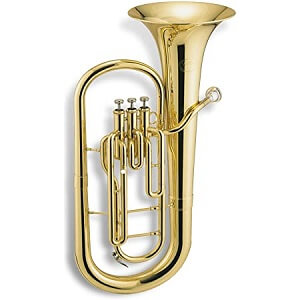Baritone Horn
 Baritone, valved brass instrument pitched in B♭ or C; it is a popular band instrument dating from the 19th century and was derived from the cornet and flügelhorn (valved bugle). It resembles the euphonium but has a narrower bore and three, rather than four or five, valves. Its range extends three octaves upward from the E below the bass staff; the notes in the treble clef are written a ninth above the actual sound. The name baritone sometimes causes confusion; in Germany and often in the United States, the instrument is called both the tenor horn and the euphonium.
Baritone, valved brass instrument pitched in B♭ or C; it is a popular band instrument dating from the 19th century and was derived from the cornet and flügelhorn (valved bugle). It resembles the euphonium but has a narrower bore and three, rather than four or five, valves. Its range extends three octaves upward from the E below the bass staff; the notes in the treble clef are written a ninth above the actual sound. The name baritone sometimes causes confusion; in Germany and often in the United States, the instrument is called both the tenor horn and the euphonium.
A valved brass instrument in the tuba family. It is pitched in B flat, the same as a trombone, and has a practical range of E to B flat1. Music for the baritone horn is typically notated in both bass clef and treble clef. This instrument is commonly used in bands both in north America and Europe.
The baritone horn, often just referred to as the baritone, is a low-pitched brass instrument. The baritone is pitched to B♭ and is usually found in brass bands. It is very similar to the euphonium, however the baritone has a tighter wrap, smaller bell and produces a lighter sound. Those that play the baritone are referred to as baritone players or a baritonist.